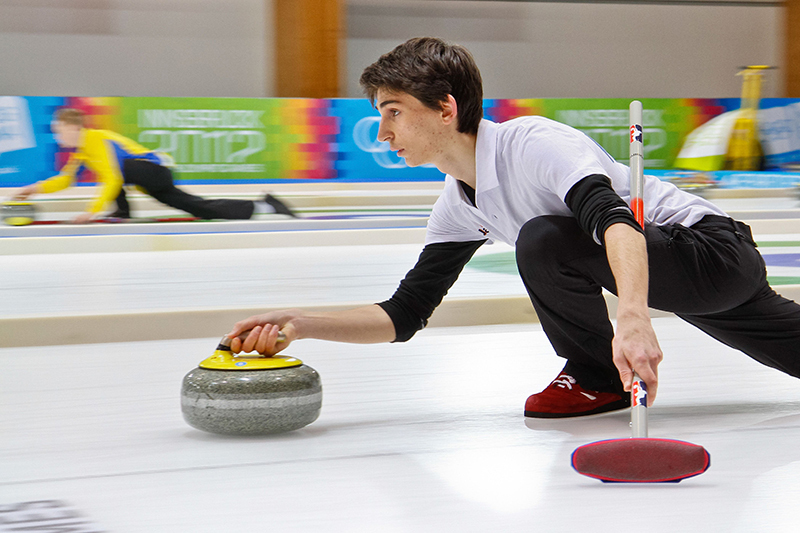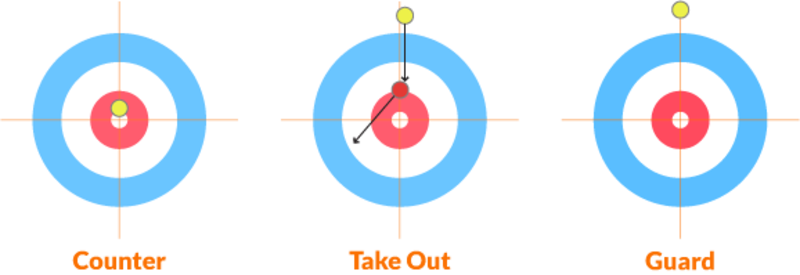Curling and rules

Curling in short
Curling is a game on ice, where the objective is to place the curling stone within a circle that is located at the opposite end of the curling track. The team that gets the closest to the centre of the circle, when all stones have been placed, receives a point or points in case of more stones. When the curling stone has left the hand of the curler, the path of the stone may be further influenced by two sweepers with brooms who accompany it as it slides down the sheet, using the brooms to alter the state of the ice in front of the stone. It is likewise also allowed to push other stones out of the circle which is known as the “house”.
Basic knowledge about curling
- Each team has 4 players (and 1 reserve at the European and World championships, as well as at the Olympics)
- In order to score points a team must have a minimum of one stone placed in or touching the edge of the “house”, that is placed better in the end than that of the opponent’s stones.
- It is possible to score more points by placing more stones in the “house” by the end of the game
- A game lasts 10 rounds with 8 curls per team – 2 curls per player
- A match cannot end in a tie – normally a game lasts 2,5 hours
- The scoreboard in the hall shows the point distribution at the end of each round and the team’s stone colour
- There is no referee – fair play is expected. Curling is a gentleman’s sport
- A lottery decides which team starts – hereafter the teams take turns to place their stones
The teams

- 2 teams with 5 players (4 players and 1 reserve)
- The lead: The player, that puts the team’s first two stones on the sheet of ice.
- The second: The player that places the teams third and fourth stones
- The third: The player that places the teams fifth and sixth stones. The third is also the vice-skip, which means, that he is placed in the house when it is the skips turn to put his/her stones in the end.
- The skip: The player that decides the team’s tactics. He stands in the house and watches the stones curl and direction, deciding how the next curl should be played. The skip normally places the last two stones in each game.
- The team’s order in connection with the stones thrown is thereby normally first, first, second second, third, third, the skip, and the skip. This makes 8 throws for each team in each end.
- The fifth player – the reserve – has the role of testing the stones with the coach before the match, as different stones have different “curls”, as it’s called.
- A team carries the same colour across all players and the reserve. The tradition is, that the teams wear light shades of colour in the uniform, if they are designated a light stone handle colour and vice-versa.
Try Sportmember for free - Create profile
The curling sheet
- The ice pitch’s dimension is 45,7 meters long and 5 meters wide. The house is located in both ends, this way it is not necessary to carry the stones back at the end of a round.

- The house is 3,66 meters in diameter
- The house looks like a shooting target, where the coloured rings indicate how close the stone is to the centre of the house, and not different point levels.

- From the Tee-line to the Hog line there is 6,4 meters
- From the one Hog line to the other Hog line there is 21,94 meters
- Hack: Similar to a starting block in track and field, the foothold device where the person who throws the stone pushes off for delivery
- Hog line: Two lines on the pitch in front of each house, the first line indicates when the stone must have left the hand of the player. If the player lets go of the handle, and thereby the stone too late, then the stone must be swept out of the field before reaching the house and the other placed stones. The other hog line indicates, together with the tee line, the “Free Guard Zone”.
- Free Guard Zone: the area of the pitch where the stone can be placed, where the opponents first player cannot take out. This rule only counts during the first 4 throws in each end – in other words, until the team’s second’s turn. Even though the player isn’t allowed to remove the opponents guard, it is allowed to remove his own first guard, with his other stone in the Free Guard Zone

- Back line: The back line marks the end of the playing field. The line is placed at the end edge of the house, even though the ice continues past this point. If a stone passes the back line, it is removed from play, as it doesn’t count anymore.
- Centre line: A line running lengthwise down the centre of the ice, cutting through both of the pitch’s tee lines.
- Side lines: A line placed at the side (perimeter) of each sheet of ice
- The house: The area within the concentric circles at each end of the sheet. The aim of the game is to place as many stones as possible on the tee line.
- Tee line: A line that runs through the middle of the house’s width.
- Tee: The centre of the house
The curling stone

A curling stone weighs 20 kg. and is 90 cm in circumference. It is cast in polished granite, and the bottom is hollow and flat, so that it glides with ease on the ice. On top, it has a handle in the colour of the team, so that you can see which stones belong to which team.
The word ’curl’, that has given the name to the sport, is a term for the curl that is given to the stone when thrown. The curl is either left-screwed (out-hand), or right screwed (in-hand) in its rotational movement, if you’re right handed, and opposite if you’re left handed. The stone is curled, so that the opponent’s guards can be avoided, and the stone can be placed behind the guard.
Scoring of points
- The closest stone to the middle of the house gets 1 point
- Only one team can score points in each end.
- Points are scored for each stone, that lays closer to the house’s middle than the opponents closest stone – maximum 8 point in each end possible, even though this is highly unlikely.

- The team that scores a point in an end, places the first stone in the next and thereby loses the “Hammer” in the new end.
- In times of doubt of which stone is placed the best in terms of the tee, it must be measured.
- It is allowed to surrender before the tenth end has been played, if a team feels that they cannot avoid losing
- In occurrences of a tie score after 10 ends, another end is played. The first team that scores a point, wins.
Tactical terms

- Counter: A stone that is placed closer to the centre of the house than that of the opponent
- Take out: Removal of a stone from the playing area by hitting it with another stone.
- Double take out: When two of the opponent’s stones are pushed out of the playing area
- Guard: A stone that is placed in a position so that it may protect another stone. There are different types of guards – a Corner Guard is placed away from the centre line, while a Centre Line Guard is place on the centre line, so that its purpose is to block for a stone that is placed in the centre of the house.
- Point-stone: The stone placed closest to the middle of the house, thereby scoring the
- Second shot: The second best placed stone
- Hammer: The last stone in an end – a huge advantage; the team with the last stone is said to "have the hammer"
- Blank end: An end in which no stones are touching the house, and thus no points are scored; in regular play the team that has the hammer retains it for the next end.
- The shoe that you glide on, has a soft sole, which makes gliding easier. The other sole is made of rubber, which is used for keeping the balance.
Sweeping with the broom
The teammates of the player, whom places the stone, has the task of sweeping in front of the stone. By sweeping you insure that the stone curls/turns less, and that it moves further down the sheet. This is because that the rubber pillow at the bottom of the broom, heats up the ice, thereby reducing the frictional resistance.
You are allowed to sweep in any direction you wish, as long as the broom doesn’t touch the stone. If this happens, the stone must be taken out of play, before it reaches the house or other stones. If it’s not taken out of play, the opposition must decide on whether to continue playing with the stones in their new positions, or whether to return them to their previous position.
Two players are allowed to sweep simultaneously, when the stone is in between the two tee-lines. If the stone has gained so much speed and distance as a result of sweeping, that it passes the tee-line in the house, then only one player may sweep it. Additionally, when a stone crosses the tee line, one player from the other team is allowed to sweep it. This is the only case that a stone may be swept by an opposing team member. In international rules, this player must be the skip; or if the skip is throwing, then the sweeping player must be the third.